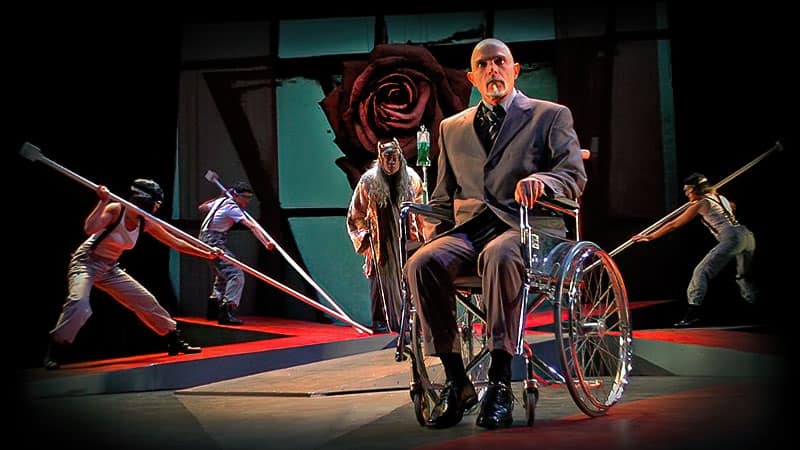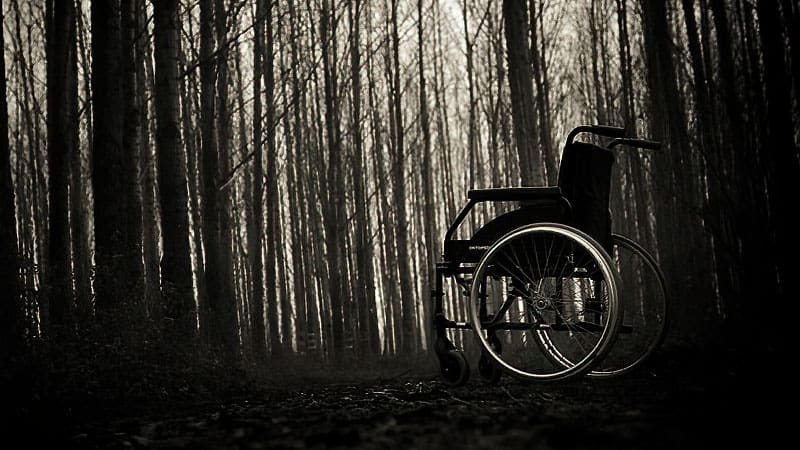Hi, Scott Swenson here from Scott in the Dark Periodic Podcast for Haunters, and today’s Haunt hack is all about making certain that guests who happen to have disabilities can fully enjoy our haunted attractions.
Listen Here
Scott Isn’t An ADA Expert, And Why He Uses The Term Disabled Guests
Now, since I am not an expert in ADA or its regulations, I’m going to assume that you’ve already done all of that research in your design and operation of your haunted attraction. If you do have any questions, you can of course go to ADA.gov, or there’s a lot of other online resources. The purpose of today’s hacks are to actually make certain that we’ve done our due diligence and ways to continue to double-check to make certain that guests with disabilities are going to perceive our haunt in a positive way.
I do use the term guests with disabilities, or disabled guests, and I do that because having completed my certificate program in diversity, equity, and inclusion. I had a great speaker who was disabled, and she said that she wears her term disabled like a badge of honor because being disabled gives her a different perspective from other people. So, I so respected her approach and I want to make certain that I am honoring her and her approach to her disability. So, that’s why I’m not using any other terms, because I was in essence told not to, so that’s why I’m using that term.

How To Make Your Haunt Better Than ADA Guidelines In One Step
I think first and foremost the number one thing you need to do is, you followed all the regulations, you’ve measured everything you’ve made certain that everything is, you know, up to code, up to spec, but I think the most important thing you can do is to actually invite some folks who are disabled, who have mobility issues, who have maybe visibility issues, even hearing issues, to experience your haunt and see what they recommend.
You know, we can always second guess what we think people with disabilities are going to need, and make a checkmark next to everything that the ADA rules say we have to, but if our true goal is to make certain that disabled guests are able to enjoy our haunt like everybody else, then who better to ask than folks who are disabled? I’ve discovered in my years working through, that to actually ask a guest who normally is in a wheelchair, “What can we fix? What can we tweak?” It does a couple of things. Number one, it makes me notice things I’ve never seen before and number two, it shows that ADA is a bare minimum and that quite often in the real-world ADA regulations aren’t quite enough or aren’t exactly what folks need. So, it’s always good to get that sort of additional eye on your product to make certain that everybody can enjoy it.
Wheelchairs Come In Multiple Widths And Have Varied Turning Radius’
One of the things that I did learn from those particular guests in wheelchairs, specifically from those guests in electric wheelchairs. The last time I was looking at ADA closely, it basically says make reasonable accommodations for guests in standard wheelchairs. But, as we all know, some of these electric wheelchairs are, well, to be honest, larger than my car. So, you have to make certain that you have the proper turning radius and to make certain that you know not only can the guests enjoy their experience but also that they don’t get stuck and get put in an embarrassing situation where they’re holding up a line or they have to you have to shut down the house in order to get their oversized electric wheelchair out of your haunt.
What Scott Swenson strongly recommend is, even if you are not disabled and you can’t find someone who is in a wheelchair to sort of test things out for you, get a wheelchair and test it out yourself; see what the frustrations are, see where their turning points are. It’s not just widths of hallways, it’s also turning radius, and props that may be in the way, things that they may not go over, et cetera, et cetera, et cetera. So, don’t just use your ruler or your tape measure to make certain that you’ve made your haunt ADA compliant, make it so that you truly make it enjoyable for guests with disabilities.

Some of Scotts Simple Tips For Meeting ADA
I have little tricks that I use because I just happen to know that back in the day, and I think it’s still the case, that the ADA regulation for height is 6 feet 8 inches and I am roughly 6 feet 4 inches, and I know that if I put my hand in a fist on top of my head with my thumb down and my pinky finger up, that that is roughly 6 feet 8 inches. So, I can walk through a haunt, whether I have a measuring device or not, put my hand on my head and go, “oh that’s too short,” or “oh that’s tall enough.”
So, what Scott Swenson recommend to you is to figure out that for you, whether you know, depending on how tall you are, figure out what your hand position is, or maybe even just get a hat that when you’re wearing it, you know you’re 6 feet 8 inches tall. You can always carry a tape measure with you, and many people do, but it’s just much quicker for me to have those little cheats where I can put my hand on my head and say, “OK, that’s 6 feet 8 inches,” or I know that roughly from my nose to my thumb is about 36 inches. So, if I’m measuring like the width of a door frame I can go, “Yep, we’re good. We’re right on track.”
Disabled Guests Are Still Guests!
Now, if for some reason you have something in your haunt that a guest in a wheelchair, or a guest with mobility issues, can’t experience and you have to create a bypass for it, make certain you don’t make the bypass just an empty hallway; because again, these are guests in your haunt as well. So, make sure it’s fully themed, fully decorated, and if you’ve got an actor that you can pop in there that will maybe work. Say, for example, you’ve got a vortex tunnel and you can’t afford to build the inch per foot ramp that you need, you don’t have the space, or you don’t have the money, so you have to do stairs, therefore you have to do a bypass for it. Maybe you have it so the actor plays both the vortex tunnel and the bypass so that the guest in the wheelchair has the same quality experience that anybody else has.
I think the most important thing to recognize is, in recognizing the ADA regulations and exceeding them, because I think that’s our really our responsibility, we’re not making it so that we get by, we’re not making it so haunted attractions can open, what we’re doing is we’re making it so that guests who have disabilities can enjoy our haunts the same way everyone else can. I think that is really just not only good business, but it’s also good for our industry in general, and really good for our planet. ADA is a great jumping-off point, but take some of these hacks and see if you can double-check and make sure that guests with disabilities are able to enjoy your hunt the way everybody else does.
Scott’s Mandatory Self Promotion
Or
To Learn More About Scott Swenson
If you’d like to learn more about what I think about haunting or how I approach haunting, please listen to my podcast, A Scott in the Dark Periodic Podcast for Haunters, you can also watch it, or you can get one of my many books. I have, well, a bunch, or you can go to my website A Scott in the Dark and subscribe to my newsletter. Until next time, this is Scott Swenson from Scott in the Dark saying, happy haunting.